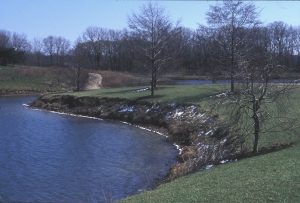Treatment 1: Clay Soil Shelf
Compacted clay was used to create shelves along the shoreline varying in width from 10 to 40 feet. The shelves were constructed with a gradual slope (10H to 20H:1V) until the outside edge and then a 3H:1V slope down to the bottom of the lake. Angular stone was placed at the outside edge to protect the shelf's soil from the energy of incoming waves.

Treatment 1:
Cross-sectional view, with wide planting shelf
including floating leaved plants

Treatment 1 Alternative:
Cross-sectional view, with a narrower
planting shelf
From approximately normal water line to the outside edge, the shelf was covered with benthic mesh and planted with emergent and floating-leaved vegetation. Energy dissipation and shoreline protection occurs primarily as a result of the broad shallow-water shelf. Particularly during the non-growing season, the vegetation per se is not the most important mechanism for wave energy dissipation. Rather, the plant roots provide critical soil stability and therefore soil retention along the width of the shelf.
This method provides long term shoreline stabilization and at the same time creates valuable wetland and aquatic habitat. The primary disadvantage to this approach is that it requires the lake system to be drawn down during construction to allow compaction of the clay planting shelves.

Treatment 1: Before shoreline restoration

Treatment 2: After shoreline restoration
